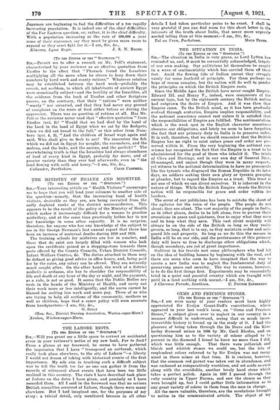GEMS AND PRECIOUS STONES.
[To 2TIE EDITOR OF THE " SPECTATOR."]
am sure many of your readers must have highly appreciated Sir Evelyn Grant-Duff's contribution, which appeared in your last week's issue, on "Gems and Precious Stones," a subject given over to neglect in our country in a manner difficult to understand, seeing that so much incon- trovertible history is bound up in 'the study of it. I had the pleasure of being taken through the De Beers and the Kim- berley diamond mines in 1886 by Mr. Cecil Rhodes, and on questioning him as to the variety of colour alleged to be present in the diamond I found he knew no more than I did,
which was little enough. That there were yellowish and bluish and whitish stones we could see, but the iris of resplendent colour referred to by Sir Evelyn was not recog- nized in those mines at that time. It is curious, however, that the common red garnet was taken out in abundance, and was reckoned as comparatively worthless, and set aside as such along with the crocidolite, another lovely hard stone which takes a perfect polish. Again in 1897 I passed through the ruby country in Upper Burma, and saw the stones as they were brought up, but I could gather little information as to any great variety of colour in them from the men in charge.
All the more valuable, therefore, are the revelations brought to notice in the communicated article. The object of my
writing, however, is to refer to the amazing knowledge of intaglio implied in the minute instructions given to Moses (circa 1500 e.c.) in the 28th chapter of Exodus, which could only have been carried out by artificers whose skill proved that they had for generations been the craftsmen of the g"yptians in this finest of the arts of that highly civilized people. We can understand that the Hebrews should be excellent shepherds, cattlemen, and brickmakers, and we are also informed that the escaped slaves carried with them gold and silver and precious stones, but that among them should be found masters of what were then the mystery crafts of the goldsmith, the silversmith, and, above all, the gem engraver, throws a side-light on the character of the horde that came out of Egypt and very quickly became the most truly refined people on the face of the earth. Theologians, in sometimes characterizing them as a semi-barbarous rabble, have missed the significance amongst them of these artists already pre- pared to carry out the work about to be allotted to them— work which would tax the most skilled craftsmen of our own
day.—I am, Sir, &c., ROBERT RULE. Be-nachie, Crieff, Perthshire.



































 Previous page
Previous page